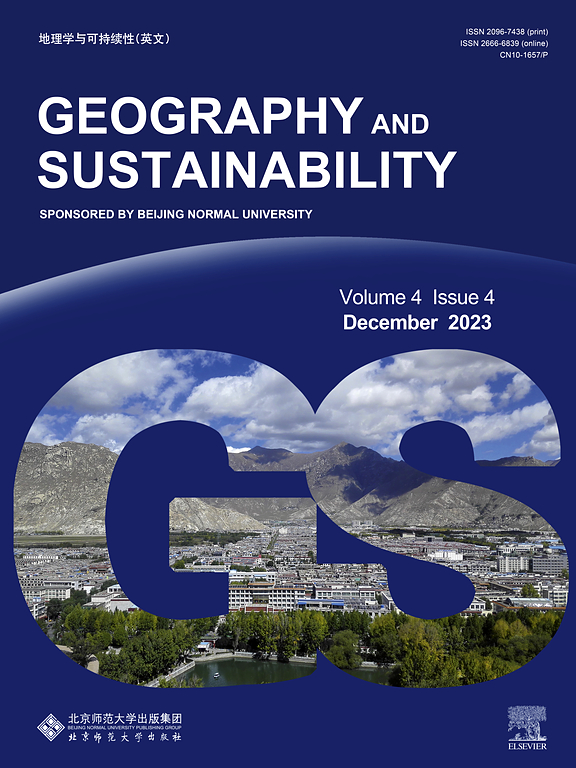西北地区融雪洪水时空分布及灾害风险评价
IF 8
1区 环境科学与生态学
Q1 GEOGRAPHY, PHYSICAL
引用次数: 0
摘要
融雪径流是西北地区水资源的重要组成部分。随着全球气候变暖和极端事件的频繁发生,融雪洪水造成了巨大的破坏。然而,目前的研究缺乏对整个NWC融雪洪水的全面研究和系统风险评估。以GLDAS-NOAH模型模拟的1948-2022年融雪径流为基础,利用NWC的POT (Peaks Over Threshold)模型反演融雪洪水的多个指标,结合社会经济数据进行综合风险评估。结果表明:西北地区融雪径流量呈显著增加趋势,呈现西北和西南边缘多、中东部少的空间格局;北疆地区融雪洪水发生频率相对较低,但震级较大,祁连山周边地区融雪洪水发生频率较高,但震级较小。积雪洪水持续时间最长的地区是喀什和雅尔喀特河。靠近山区的流域容易发生融雪洪水,特别是通天和澜沧江流域,以及艾比湖、伊犁河流域和阿尔泰山以南的河流,面临融雪洪水的风险最高。基于危害、暴露、脆弱性和适应性的综合评估,高高风险和极高高风险地区占NWC的15.5%。在大型山地盆地,加强监测预警系统建设,实施相应的防灾减灾措施刻不容缓。本文章由计算机程序翻译,如有差异,请以英文原文为准。

The spatio-temporal distribution of snowmelt floods and disaster risk assessment in the Northwest China
Snowmelt runoff is an important component of water resources in the Northwest China (NWC). With global climate warming and the increasing frequency of extreme events, snowmelt floods have caused significant damage. However, current studies lack comprehensive research and systematic risk assessments of snowmelt floods across the NWC. Based on the snowmelt runoff simulated by GLDAS-NOAH model (1948–2022), the multiple indicators of snowmelt floods were retrieved by Peaks Over Threshold (POT) model in the NWC, and comprehensive risk assessment was conducted by integrating socio-economic data. The results indicated that the snowmelt runoff in the NWC shows a significant increasing trend and exhibits a spatial pattern of being more abundant in the northwest and southwest edges while less in the central and eastern regions. In Northern Xinjiang, snowmelt floods occurred relatively infrequently but with large magnitudes, while around the Qilian Mountains, snowmelt floods were more frequent but of smaller magnitudes. The longest duration of snowmelt floods was observed in the Kashgar and Yarkant River. Basins near mountainous areas are prone to snowmelt floods, especially the Tongtian and Lancang River basins, as well as the Ebinur Lake, Ili River basin, and the rivers south of the Altai Mountains, which face the highest risk of snowmelt floods. Based on comprehensive assessment of hazard, exposure, vulnerability and adaptability, high and very high-risk areas account for 15.5 % of the NWC. It is urgent to enhance monitoring, early warning systems, and implement corresponding disaster prevention and mitigation measures in large mountainous basins.
求助全文
通过发布文献求助,成功后即可免费获取论文全文。
去求助
来源期刊

Geography and Sustainability
Social Sciences-Geography, Planning and Development
CiteScore
16.70
自引率
3.10%
发文量
32
审稿时长
41 days
期刊介绍:
Geography and Sustainability serves as a central hub for interdisciplinary research and education aimed at promoting sustainable development from an integrated geography perspective. By bridging natural and human sciences, the journal fosters broader analysis and innovative thinking on global and regional sustainability issues.
Geography and Sustainability welcomes original, high-quality research articles, review articles, short communications, technical comments, perspective articles and editorials on the following themes:
Geographical Processes: Interactions with and between water, soil, atmosphere and the biosphere and their spatio-temporal variations;
Human-Environmental Systems: Interactions between humans and the environment, resilience of socio-ecological systems and vulnerability;
Ecosystem Services and Human Wellbeing: Ecosystem structure, processes, services and their linkages with human wellbeing;
Sustainable Development: Theory, practice and critical challenges in sustainable development.
 求助内容:
求助内容: 应助结果提醒方式:
应助结果提醒方式:


